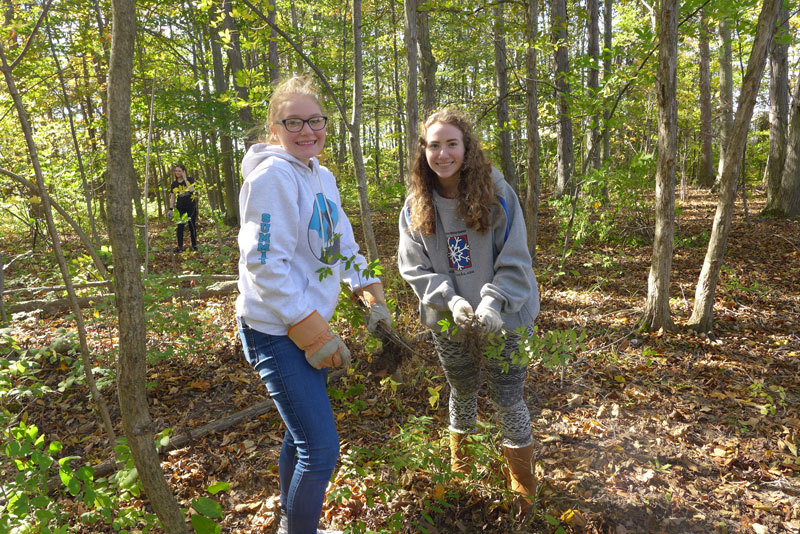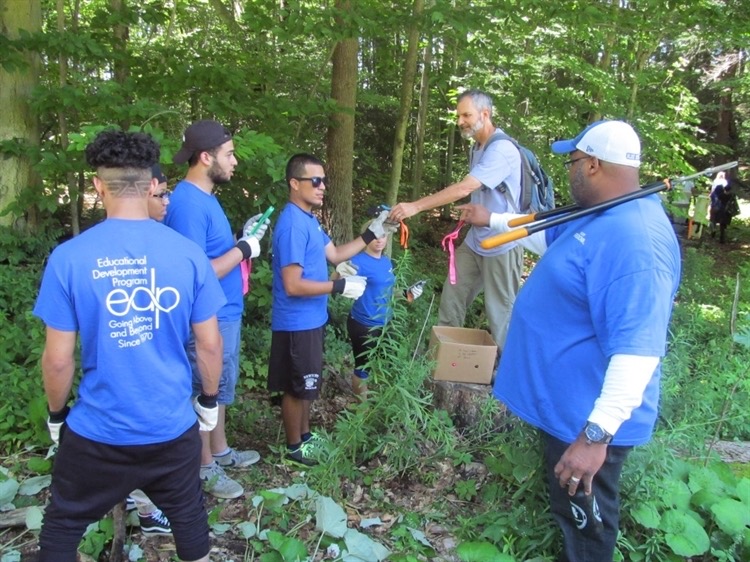DAKOTA RICHTER
Special to The Leader

In the Campus Woodlot located near Ring Road, there are multiple invasive species in the perimeters of the roughly 14-acre forest. These invasive species were brought to the area by humans for landscaping and grew beyond their original ecosystems. In addition, animals such as birds consume the seeds of invasive plants and excrete them in new locations.
There are three species in particular that have not only caught the attention of science majors but WNY PRISM, an invasive species management group. WNY PRISM is one of eight regional partnerships in New York State that was created to help reduce the harm caused by invasive species to New York’s environment, economy and human health. The three main invasive species found at Fredonia are Privet, Honeysuckle and Buckthorn. The trio are all invasive species that have threatened Fredonia’s biodiversity and wildlife and continue to still do so. However, invasive species pulls are being planned out and executed to combat them. One of the earliest pulls started back in 2008. Pulls are used to target the plants at the source and pull them out of the ground before maturing.
“[Invasive species] don’t benefit local ecosystems just the same way harmful germs don’t benefit the body,” said Justine Bloom, treasurer of Fredonia’s Sustainability Club and a junior environmental earth science major.
Invasive species pulls are an organized event through FREDGrows, which is Fredonia’s campus sustainability club. Before this primarily annual event came to be, all three of these invasive species were much more aggressive and overgrown. They were able to flourish because the campus left them unchecked in the woods.
These invasive species outcompete the native plants by growing at their own volition, taking over the ground cover and outshading the native plants that grow on the forest floor. These invasive species provide little to no nutrition for the wildlife that resides in the woods.
Out of all three, the one in particular we should pay attention to the most is the Eursaion invasive species Honeysuckle. These shrubs grow leaves very early in the spring, and retain them late into the fall compared to native plant species. They jeopardize the native species ability to photosynthesize because the invasive species covers them.
On Oct. 14 and Oct. 15, FREDGrows held their annual invasive species pull. The pull was administered by Justine Bloom, a junior environmental earth science major, who helped with the formation of the Sustainability club in spring 2020. They made us aware of how Fredonia targets and keeps control of these invasive species.
Fredonia’s main way of targeting them is through these invasive species pulls. During pulls, students and professors will go to the Campus Woodlot and will find the species and pull them out of the ground before they reach maturity. This is also an opportunity for science majors to get an environmental action activity done as well. The activities provide students with the opportunity to go out into the field and learn something new.
SUNY Fredonia’s Intro to Ecology & Evolution lab hosts experiments in the woods. In previous years, the excursions have included an invasive species pull in the fall. This year, the lab did not have an invasive species pull. However, in Fall of 2023 they plan on doing one.
But student-led pulls aren’t the only thing that keeps these invasive species in check.
In the past, WNY PRISM has visited Fredonia and gone to the Campus Woodlot to remove larger invasive species. The species were already too big to just be pulled out by participants. As a result, PRISM cut them down and painted the cut stumps with herbicide to kill the roots, preventing these bigger ones from growing back.
WNY’s Prism visit brought attention to the importance of the invasive species pull. When the pulls first started, attendance was high.

However, shortly before and after covid, student attendance has been on a decline. Dr. Titus, a former biology professor and Bloom both came to two conclusions as to why this is.
“[Students] were losing interest in A. Environmental things and B. Actually getting out into the field and working with their hands,” said Bloom.
Even with attendance dwindling, there haven’t been any major signs of the invasive species becoming more aggressive. But, that doesn’t mean we shouldn’t be proactive about getting these invasive plants out.
Currently when the pulls are happening out in the forest they target satellite populations, which are new occurrences of invasive species trying to spread exponentially. In some areas the natives have already succumbed to the invasive species’ aggressive way of spreading. However, with these pulls, invasive species can be prevented from spreading into new areas.
While some invasive species may look beautiful to the eye, looks can be deceiving, as they do a lot more harm than good. For Fredonia’s biodiversity and animals to keep on maintaining a stable relationship with the environment, efforts need to be made to continue to keep on tackling the invasive species at the source. With attendance dwindling down at the pulls in recent years, it gives invasive species more of an opportunity to take over the native plants on campus. The only way we can keep this from happening is if attendance increases at the events once more.
“Satellite populations…if we don’t take them out they will spread and infect an entire new area…there killing new native species instead of being anchored along the edges — the natives there are already gone,” said Bloom. “But, if we can prevent them from reaching into new areas that were previously not affected by natives, the [pulls] can have a visible positive benefit.”

What are invasive plant species?:
Sunlight, air and moisture are essential for optimal growth of most plant species on Earth. However, when invasive species get introduced to a native species, this usually results in these factors getting limited. Invasive species are non-native species that can cause harm to the environment, the economy or human health (DEC NY, 2011). Invasive species can cause habitat degradation, loss of native plants, and loss of wildlife. Native species give shelter to animals and provide a food source to the whole ecosystem. When an invasive species is introduced the native plants can’t compete and ultimately get taken over. This causes a loss of biodiversity and leads to parts higher in the ecosystem to be affected (Audubon NY, 2022). Invasive species are usually fast growing and hard to get rid of if not maintained properly.
